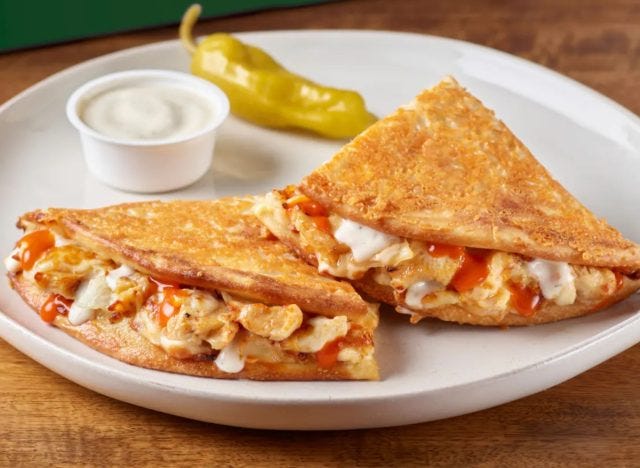Food manipulation: If your rhubarb's backwards, bend it forwards.
A recipe for rhubarb strudel
Injections to encourage weight loss have been getting wide media attention of late.

Semaglutide, recently approved by the UK’s health watchdog, apparently helps you feel fuller for longer by reducing the speed with which food evacuates the body. It also suppresses the pleasure centre in your brain to curb your food cravings, and can lower your ‘set point’, the weight which your body fights to maintain.
If you have any loose change hanging about, this looks like it could be something to invest in. It would be ironic if it made significant enough inroads into solving the obesity problem to give you the same return you would get if you had invested early in the processed food industry - the cause of so many weight gain problems. For those who bought a $4.42 share in January 2000 in Yum! Brands, the company which owns, among others, Pizza Hut, KFC and Taco Bell, its closing stock price on April 28, 2023 was $140.58.
Processed food companies employ whole departments of food engineers. Yes, that’s their job title, and, as with engines, involves a lot of oil - and salt. These scientists are dedicated to inventing stuff at a price that is affordable that will trigger the pleasure centre of your brain, tempting you to eat but then leave you craving more.
Massive investments go towards research into stimulating activity in this orbitofrontal cortex. It’s promoted primarily by fats and salts and by a considered balance of textures soft and crunchy which together arouse cravings for certain foods. If you can batter and double-fry a burrito/sandwich/burger/pizza/hot dog, why not?
With its completely opposing goal, the approval of Semaglutide, sold as Ozempic, Wegovy and Rybelsus, could turn into a fight between the pharmaceutical industry and the industrial food business. Where that would position the USA’s Food & Drug Administration which oversees both industries under one single banner,(reflecting, you might suppose, a conflict of interest), will be interesting. Some well-known food companies are symbiotically engaged in both enterprises, too.
With each season’s deluge of new products, portably packaged so that washing up is no longer part of eating, food engineers are in pursuit of the perfect ratio of fat/salt. It’s pretty much a fifty-fifty split, with some lactic or citric acid thrown in to get your saliva flowing. Their formulas are behind such mouth-wateringly nutritious inventions as Papa Johns’ Parmesan Crusted Grilled Buffalo Chicken Papadia.
It’s 1,050 calories of an average man’s daily 2,500 calorie intake or a woman’s 2000, of which 22 grams are saturated fat, 2 grams are trans fat, 3,70 milligrams are salt, 80 grams are carbs and 74 are protein. Or how about Burger King’s Egg-normous Burrito; or pizzas whose crusts are stuffed with cheese or hot dogs. Grab a sachet of sauce, why don’t you, to dip your oiled and salted calories into. At Taco Bell, diners go through eight billion of them a year. That’s more than the number of people on earth.
Processed fast foods are fiercely protected by patents. Perhaps a trick to deciding whether you’re about to make the right health choice in what you want to put into your mouth and around your heart arteries and midriff is to consider whether your particular temptation du jour has had any relationship at any point with the soil, or has instead been patented.
While seed varieties also undergo development, farmers can’t patent the bounty they sell from their own fields. Yet agrochemical and agricultural biotechnology corporations have meddled with nature to their investors’ advantage, patenting genes that cause some grains to grow shorter or fatter or in need of less water or more patented fertiliser.
Who is fighting for our health with the same level of investment in natural, organic or regenerative farming? Investors in such projects would be unlikely to reap financial rewards anywhere close in equivalence to investments in Big Food Biz. The most significant reward most of us get from supporting producers is the weekly delivery of a farm box.
Even plant-based alternatives to meat and dairy foods aren’t spared the accusation of being processed. There are those who contend that many of these analogue products not only don’t have the taste and texture - or price point - of the meats they attempt to replace, but that they are as highly manipulated as fast foods.
From the time caveman sun- or wind-dried the meat he had hunted down, food has been processed in some fashion, not all of it unhealthily. In 1795 the French Directorate, the governing five-member committee of France’s First Republic, offered a prize of 12,000 francs to anyone who could find a way to preserve food for transportation. Nicolas Appert, a chef, confectioner and distiller, found a way to do so by sealing it hermetically in glass containers reinforced with wire and sealing wax then cooked in boiling water. It’s the method still in use today across French homes and factories, and everywhere else around the world that certain foods are preserved.
Big Food Biz became eagerly involved in processing fast foods in the 1940s and 50s, providing us with stuff to eat that didn’t require much involvement on the part of the householder. It has been suggested that obesity arrived at the time American vehicles went from stick shift to automatic transmission, leaving one hand free for a fast food meal.
What is it about a Domino's Chicken Bacon Ranch Oven-Baked Sandwich at 900 calories, 44 g fat, 2,380 mg sodium and 74 g carbs that says healthy to you? (Though it does contain 46g of protein.) Rather than approve and support massive investment into pharmaceuticals to reduce the body’s cravings for stuff that has limited nutritional value, couldn’t governments re-balance the benefits of investing in the processed food business and skew them towards more seductive incentives in investing in natural, organic, small, and regenerative farming? Something along the lines of developers committing to a percentage of social housing? These latter forms of food production just don’t stand a chance against McDonalds and its ilk. And our health doesn’t either.
My father, an enthusiastic gardener, had a joke he was very fond of at this time of year that hints at food manipulation. “If your rhubarb’s backward,” he would declare, “bend it forward.” It took me decades to realise that by ‘backward’ he meant ‘tardy’. Understanding it didn’t improve the pun. For these the last few weeks of the rhubarb season, here is a recipe for rhubarb strudel. I forgot to take a photograph of the result before it came under attack.
500g/1lb fresh rhubarb
9 sheets phyllo pastry (half a packet)
225g/1 cup butter, melted
225g crushed amaretti (about 8)
90g/½ cup brown sugar
2 teaspoons ground cinnamon or ground ginger
grated zest of one large orange, scrubbed
75g/½ cup chopped walnuts
Crème fraîche, double cream, crème anglaise or vanilla ice cream to serve
Preheat oven to 180C/375F.
Slice the rhubarb into 2cm/¾in chunks.Blanch them in boiling water 1½ minutes, drain and pat dry.
Lay a sheet of phyllo on a clean counter or large baking sheet. Keep the rest covered with a damp cloth - it dries out fast! Brush the sheet with melted butter then sprinkle it with 2 or 3 tablespoons of amaretti crumbs. Repeat four more times, using up all the amaretti crumbs up then add two more buttered sheets without amaretti.
Spoon the rhubarb pieces in a compact tube-shaped line along the longer side of the phyllo, 5cm/2 inches away from its edge. Sprinkle it with the sugar, cinnamon or ginger, orange zest and walnuts. Lay over 2 more sheets of phyllo, brushing each of them with butter.
Starting from the rhubarb edge of the phyllo, roll up the sheets tightly like a roulard cake. Set the roll seam side down onto a baking sheet, tucking the ends underneath it, and brush the roll with butter.
Bake 40-50 minutes till golden. Rest it 4-5 minutes before slicing it, most easily with a serrated bread knife. Serve with crème fraîche, double cream, crème anglaise or vanilla ice cream. It is also good at room temperature or even cold. I had the left overs for breakfast.





A terrific post - so informative! And sadly, very hard to imagine people giving up processed foods. In some cases, it's cheaper to buy a fast food meal than to cook for a family...
Taco Bell is famous for giving out handfuls of their sauces with every order. People have drawers full of their sachets at home, and on the trashier end of the food writing internet you can find recipes suggesting the best ways to use them all up. Taco Bell is part cult, part fast food behemoth.